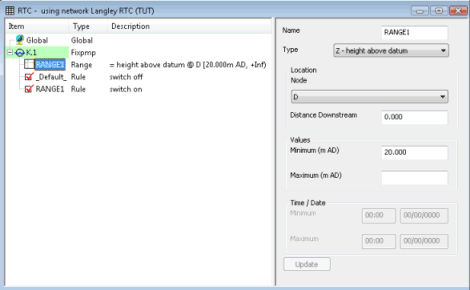RTC Window Editor - Range Pane
Ranges provide a logical output which is TRUE if the measured variable is within the defined range and FALSE if it is outside the defined range. Variables can be measured at any point in the system; they do not have to be local to a regulator.
For an example of the use of a Range see RTC Range Example.
The Range pane contains the following fields:
|
Name |
A label to identify the range |
|
Type |
The Range Type (see below). Using an invalid range type will result in the range being ignored |
|
Location: Node Link Subcatchment Regulator Pump Definition Node/Link |
Specifies where measurements are taken for this range. This should match the label of a node or link in the network. If not, the range will be ignored.
|
|
Location: Distance Downstream |
Only applicable for measurement points in conduits (pipes or channels). The position of the measurement point from the upstream end of a conduit. If a distance greater than the conduit length is given the conduit length will be used. The upstream end is assumed if the value is negative.
|
|
Values: Minimum |
Minimum numeric range value. If blank, the value defaults to minus infinity.
|
|
Values: Maximum |
Maximum numeric range value. If blank, the value defaults to infinity.
|
|
Time/Date: Minimum |
Minimum range time. If blank, the time defaults to the start time of the event. A time range should start on a major timestep |
|
Time/Date: Maximum |
Maximum range time. If blank, the time defaults to the end time of the event |
Range type
The following range types are available:
|
Type |
Description |
Location |
|
|---|---|---|---|
|
Q |
Flow |
Conduit/control |
Q |
|
V |
Velocity |
Conduit |
V |
|
Y |
Depth |
Conduit/control |
Y |
|
Z |
Level above datum |
Node |
Z |
|
R |
10 minute average rainfall |
Subcatchment |
R |
|
RINT |
Rainfall Intensity |
Subcatchment |
RINT |
|
T |
Time |
- |
dd/mm/yy-hh:mm |
|
TR |
Time Repeat |
- |
hh:mm |
|
LCT |
Local Clock Time, which takes account of daylight saving during a run |
- |
dd/mm/yy-hh:mm |
|
LCTR |
Local Clock Time Repeat, which takes account of daylight saving during a run |
- |
hh:mm |
|
DQ |
Rate of change of flow |
Conduit/control |
DQ |
|
DY |
Rate of change of depth |
Conduit/control |
DY |
|
DZ |
Rate of change of level |
Node |
DZ |
|
REG |
Regulator state |
Continuous regulator |
See Regulators for more information |
|
APC |
Adaptive pump control. True when pump has been idle longer than the calculated idle time |
Pump |
seconds |
|
PUMP |
Pump state < 0: idle time > 0: running time |
Pump |
seconds |
|
VAR |
Value of a variable, table, range or logic record |
Name of a previously defined variable, table, range or logicrecord |
- |
|
CSF1 |
Concentration of SF1, mg/l |
Link/node |
mg/l |
|
CSF2 |
Concentration of SF2, mg/l |
Link/node |
mg/l |
|
CNH4D |
Concentration of dissolved NH4, mg/l |
Link/node |
mg/l |
|
C(pollutant)1 |
Concentration of pollutant - SF1 See Table below for list of pollutants. |
Link/node |
mg/l |
|
C(pollutant)2 |
Concentration of pollutant - SF2 See Table below for list of pollutants. |
Link/node |
mg/l |
|
C(pollutant)D |
Concentration of pollutant - Dissolved See Table below for list of pollutants. |
Link/node |
mg/l |
|
C(pollutant)T |
Concentration of pollutant - Total See Table below for list of pollutants |
Link/node |
mg/l |
Table of Pollutants
|
Code |
Name |
|---|---|
| BOD |
Biochemical Oxygen Demand |
| COD | Chemical Oxygen Demand |
| TKN |
Totak Kjeldahl Nitrogen |
| TPH | Total Phosphorus |
| PL1 | User Defined Pollutant 1 |
| PL2 | User Defined Pollutant 2 |
| PL3 | User Defined Pollutant 3 |
| PL4 | User Defined Pollutant 4 |

